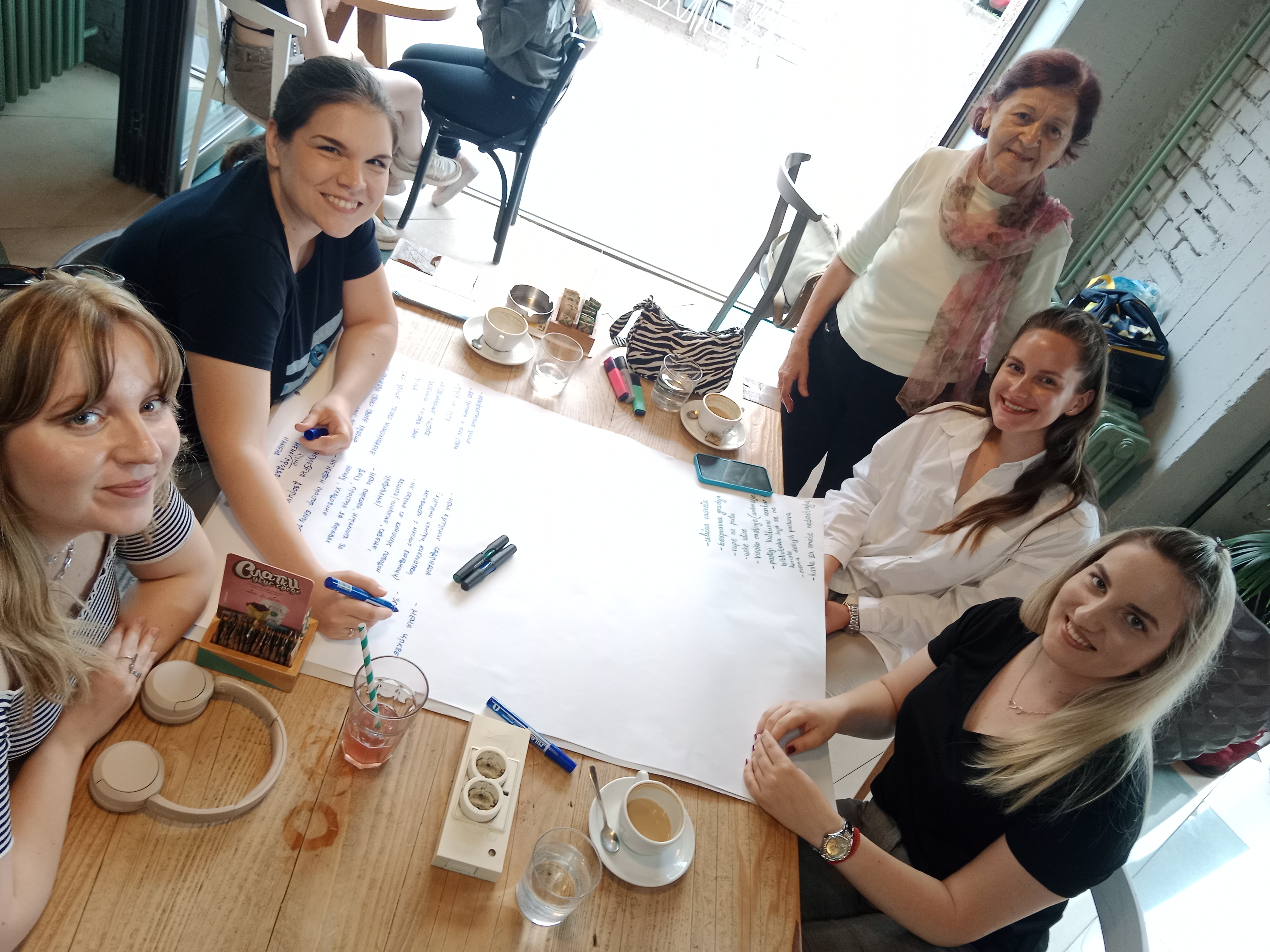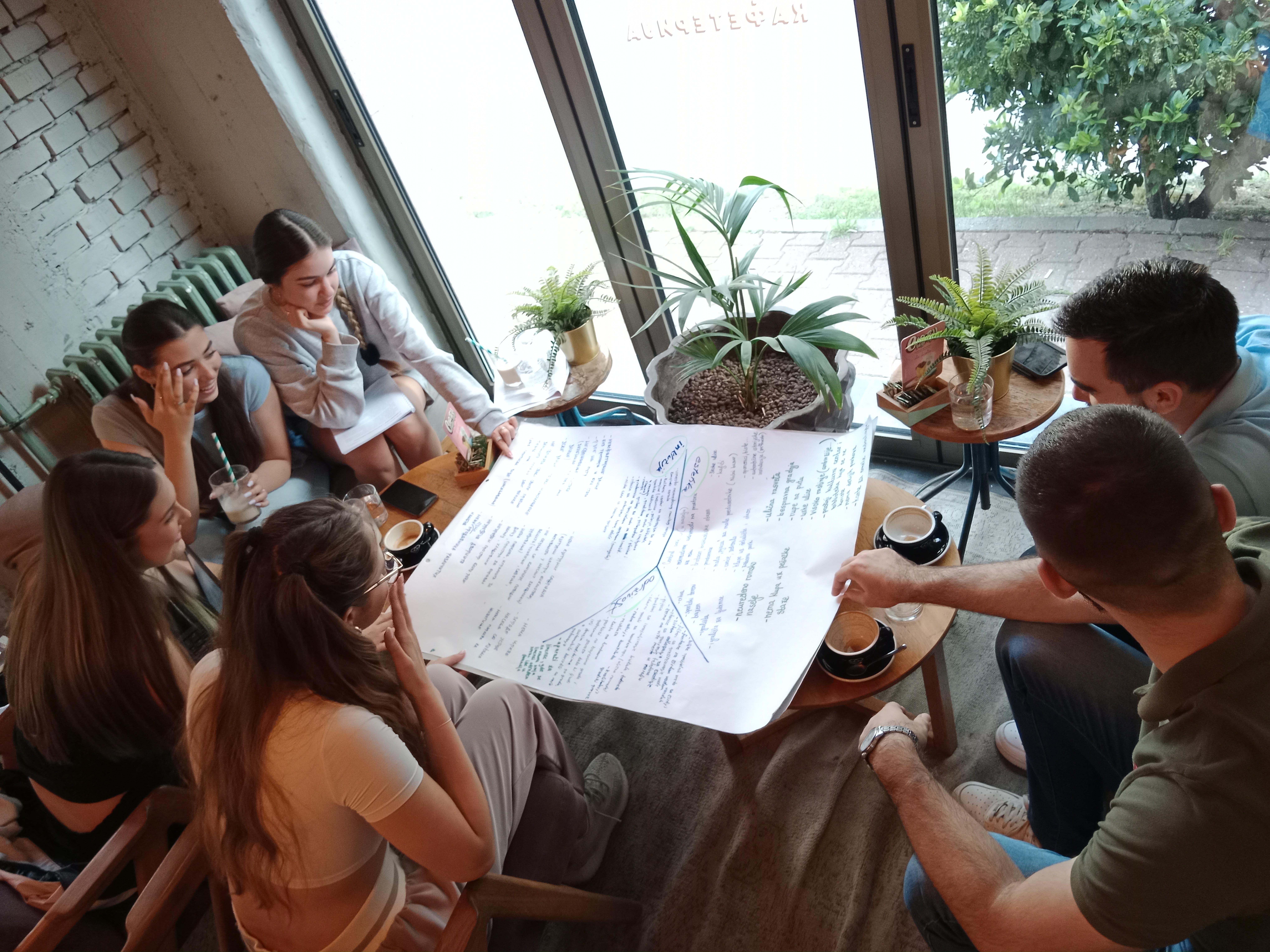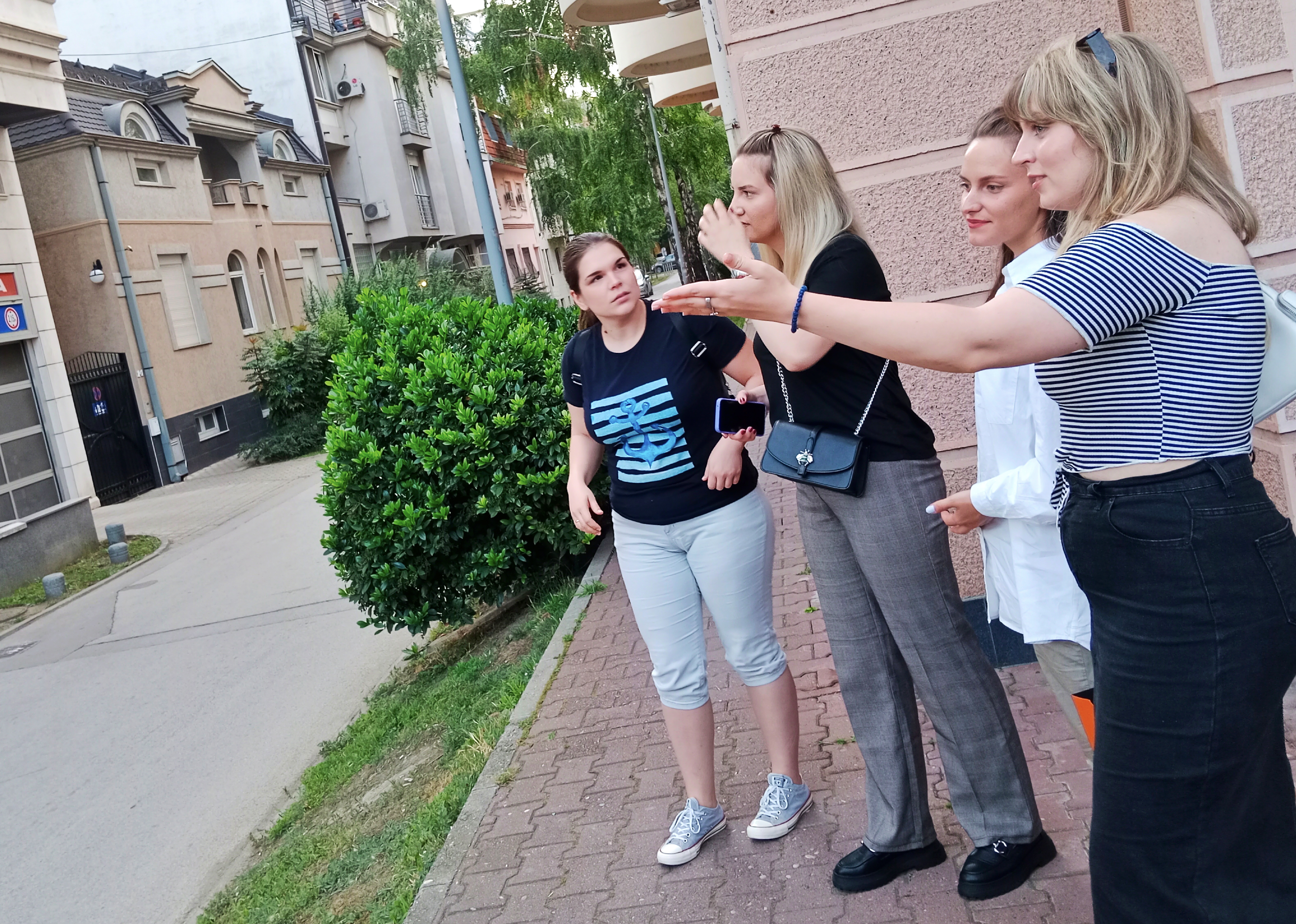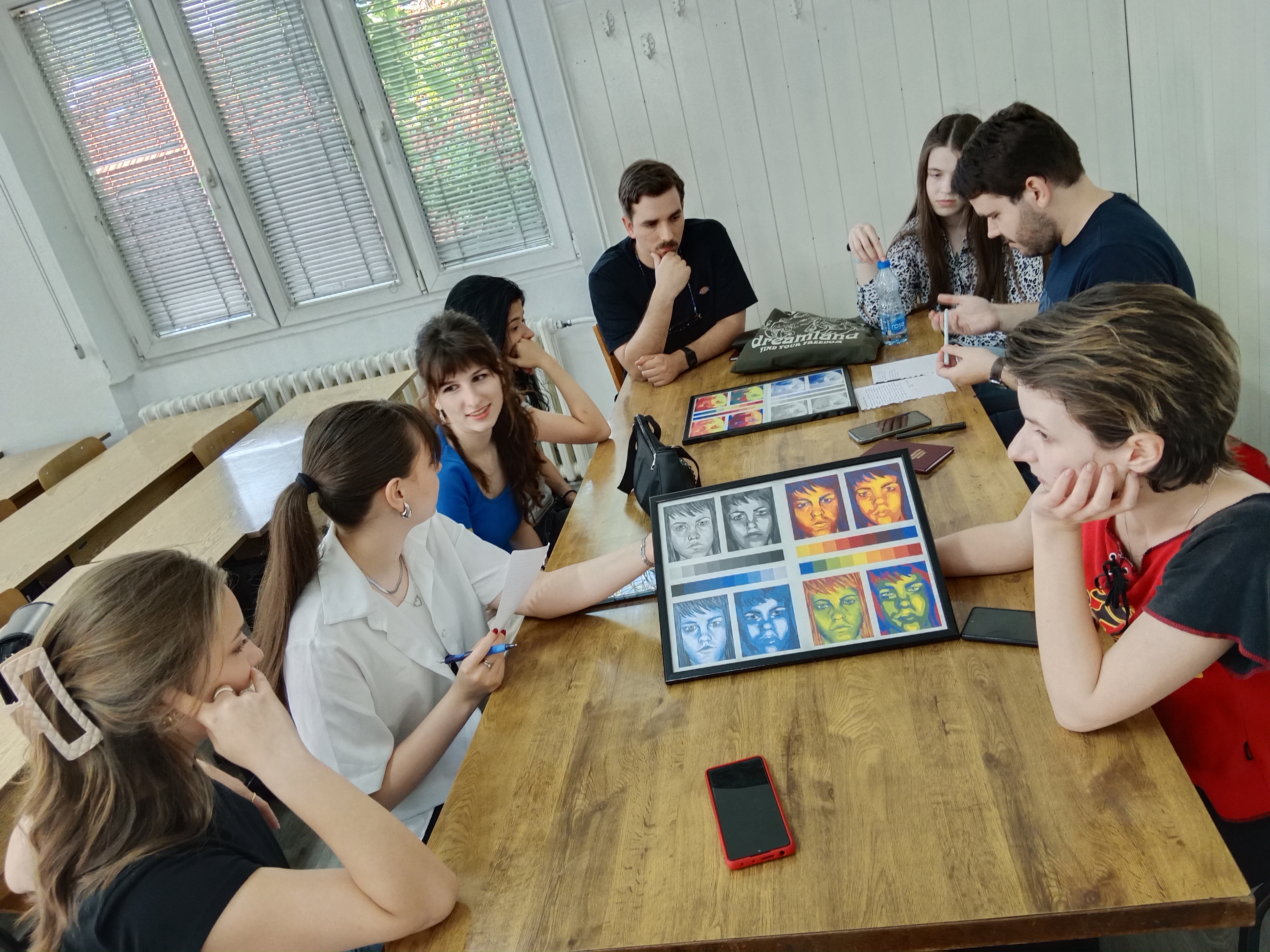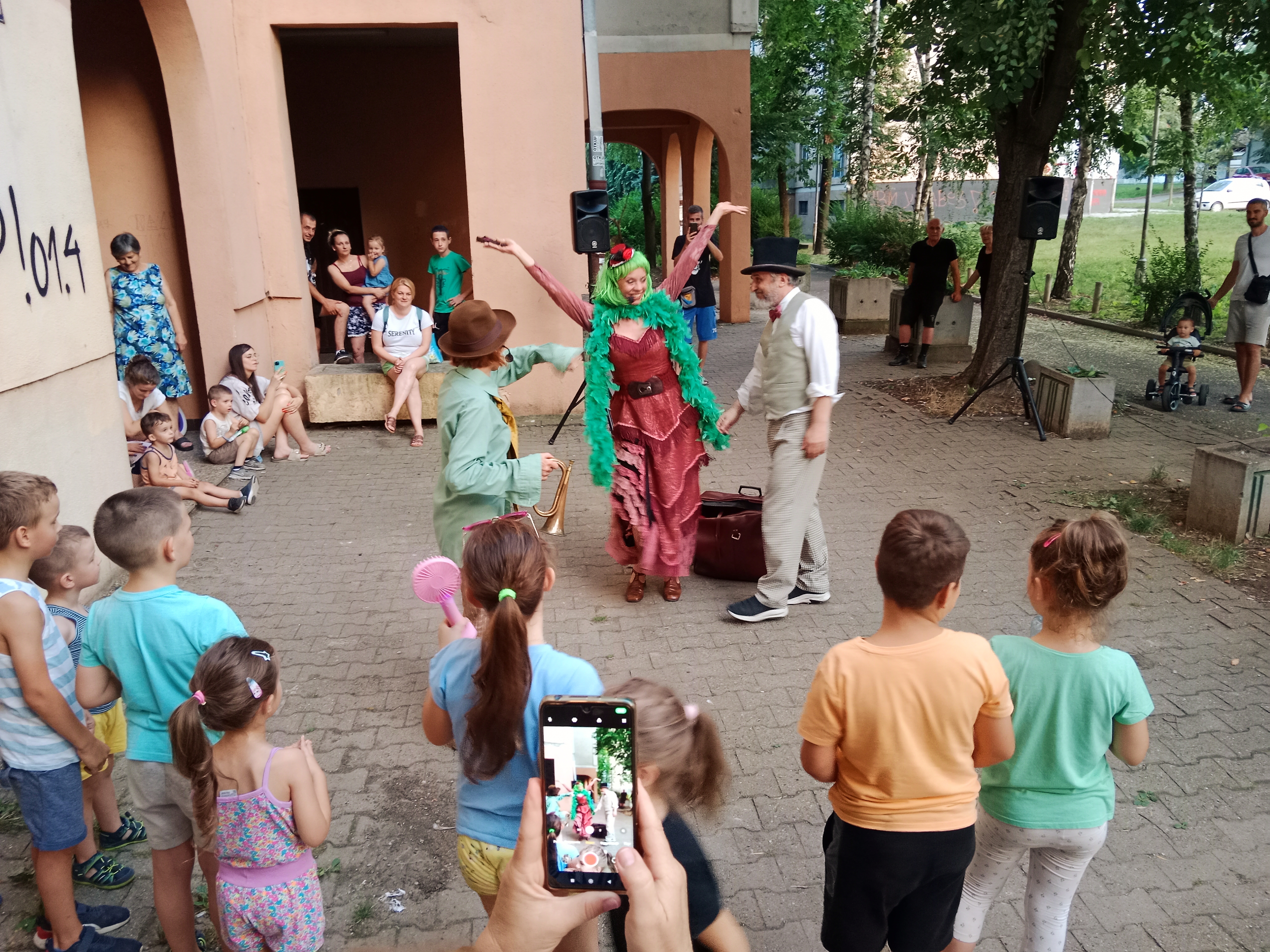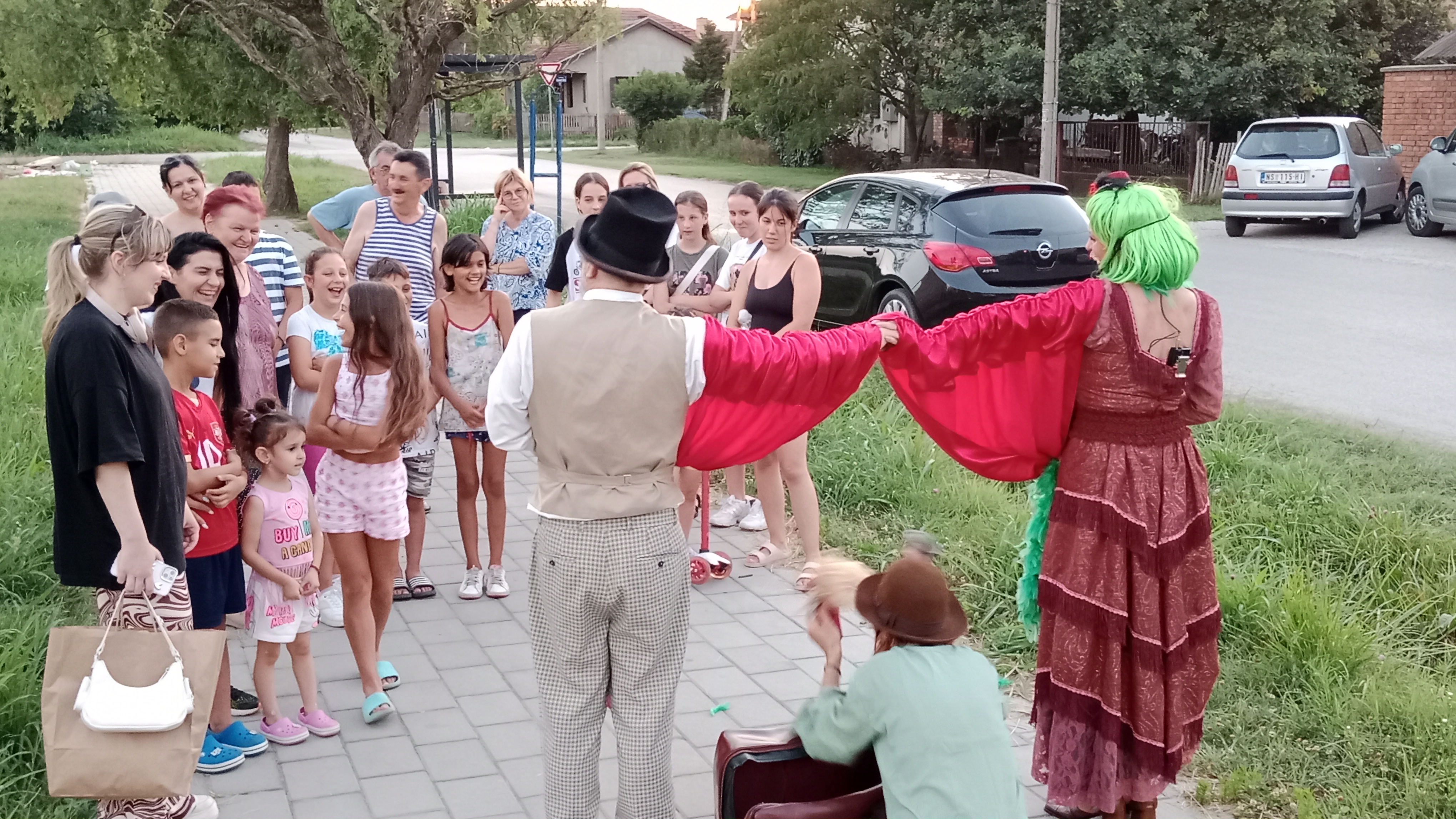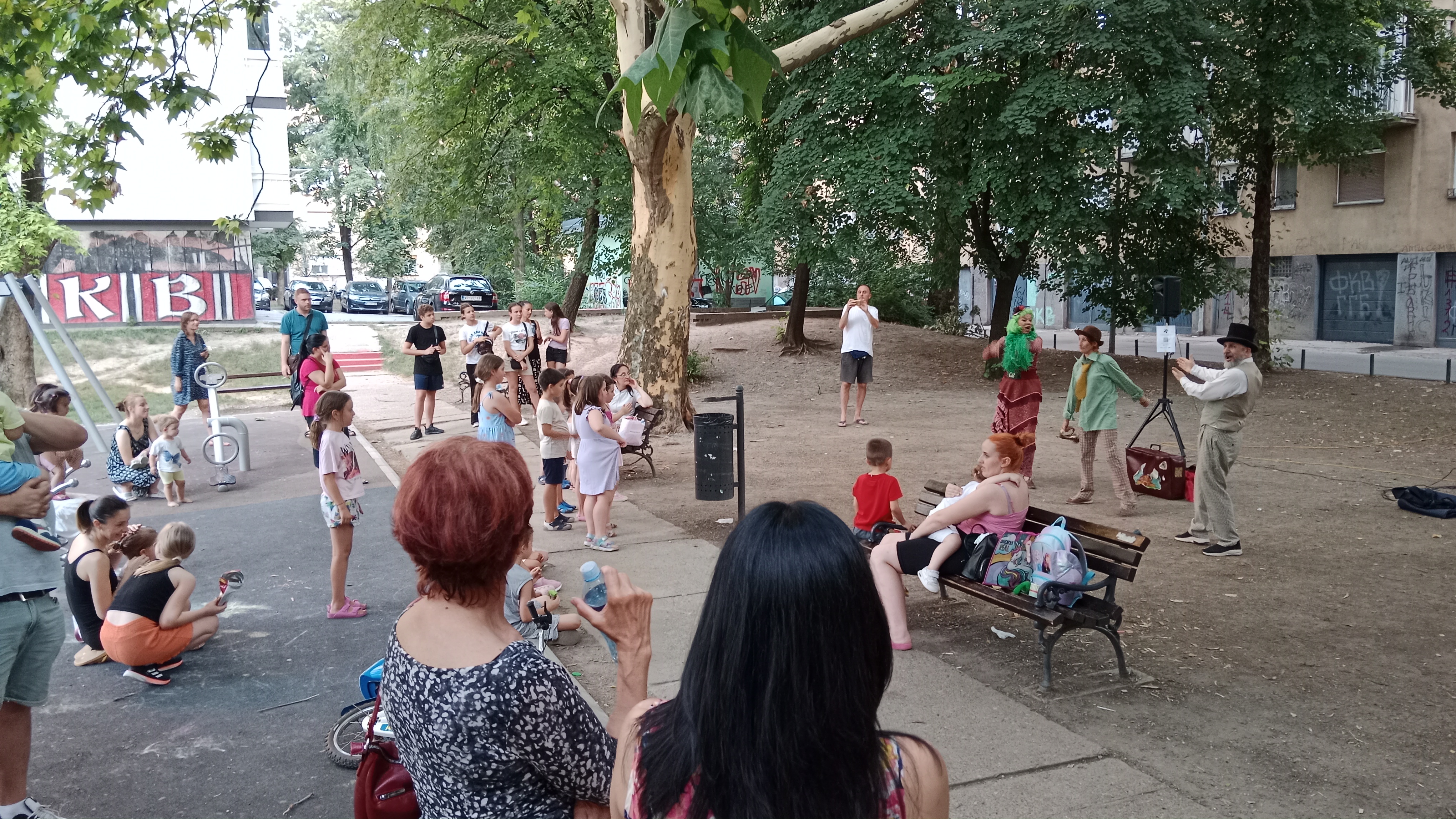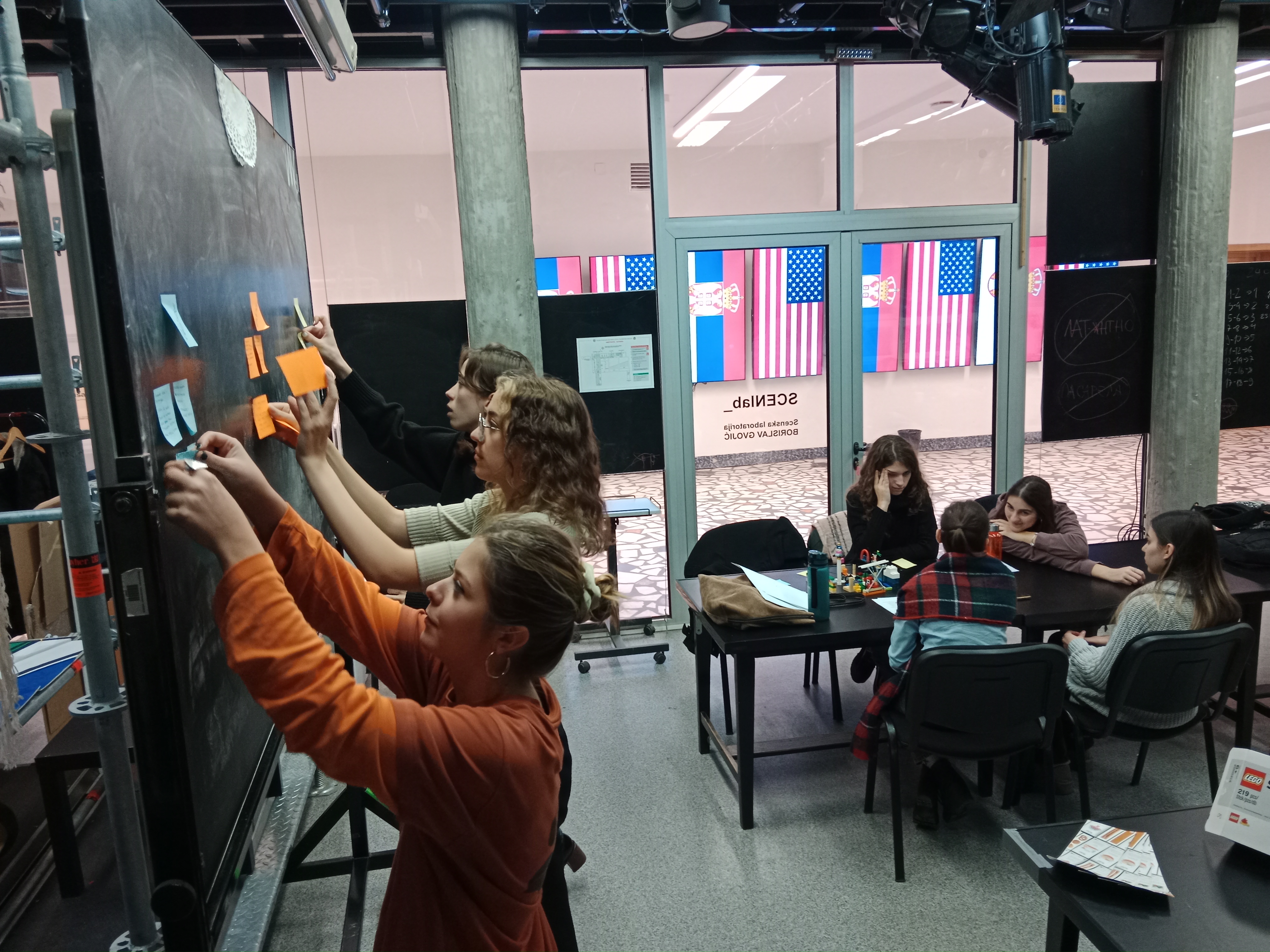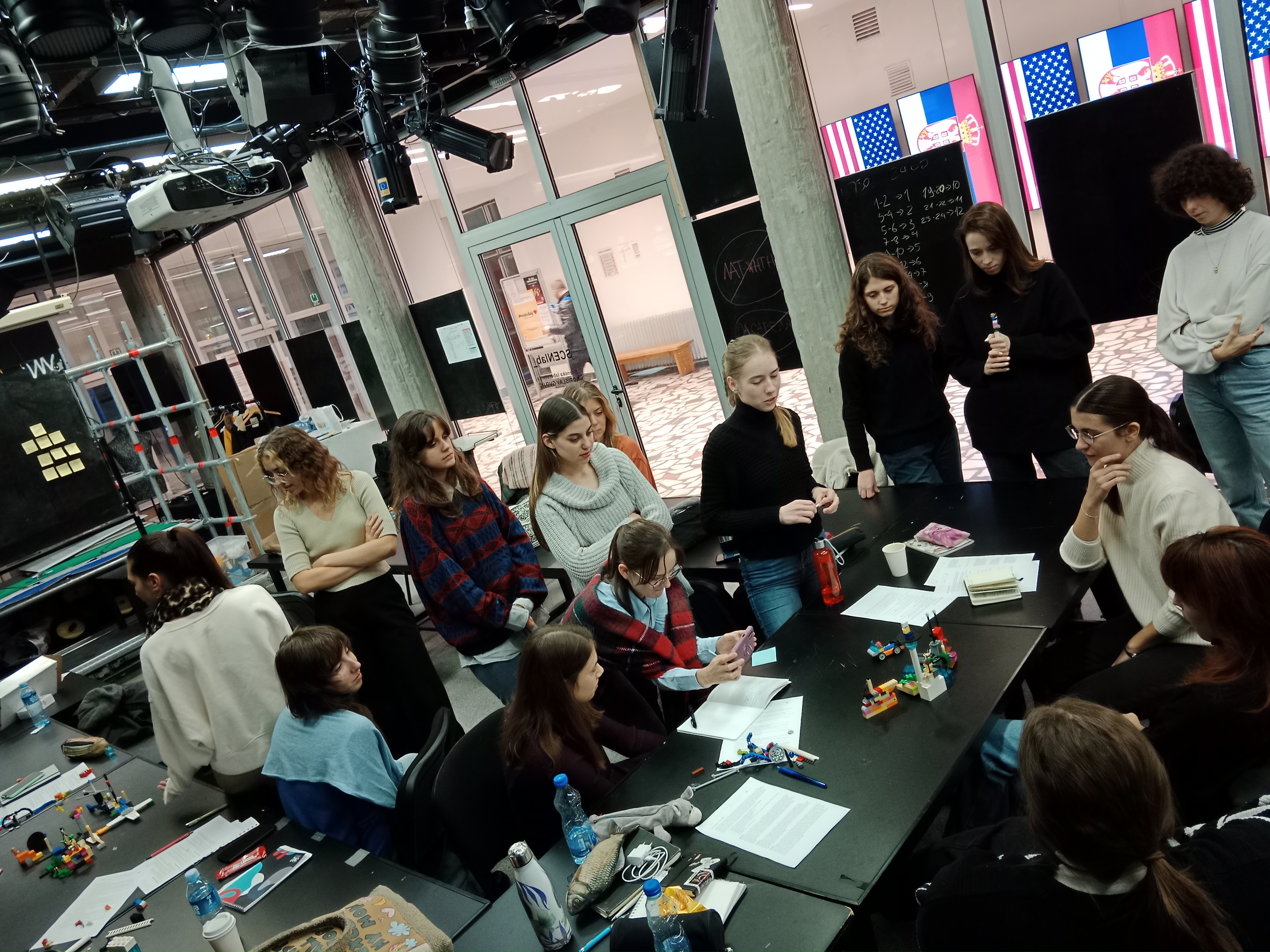Regaining a sense of belonging
PLACETHEATRE
Placemaking via street theatre and dialogues of the future
PLACETHEATRE approaches public realms of three neglected public areas in Novi Sad, Serbia, and applies innovative and unconventional art-based methodologies to help citizens regain their sense of community and belonging in a sustainable, socially-inclusive and circular manner. "Dialogues of the Future" and "Street theatres" are used to explore issues with urban but remote neighbourhoods and to help inhabitants envision a brighter future for their streets and squares.
Serbia
Local
Novi Sad
Mainly urban
It refers to other types of transformations (soft investment)
Yes
2024-11-30
No
No
No
As a representative of an organisation
PLACETHEATRE used the public realm of Novi Sad (Serbia), particularly three neglected public areas from urban but remote neighborhoods, and applied innovative and unconventional art-based methodologies (Dialogues of the Future and Street Theatre) for helping citizens and social groups at risk (minorities, refugees, females, LGBTQ, people with social and economic obstacles, disabilities) regain their sense of community and belonging in a sustainable, socially-inclusive and circular manner following the New European Bauhaus principles of inclusion, aesthetics and sustainability.
The project goal was to follow-up on the Novi Sad 2022 EU Capital of Culture citizen engagement base and fill the placemaking gaps by taking advantage of a cultural momentum and spirit initiated in the city. This helped activate citizen-driven solutions, support local authorities in placemaking and strengthen collaboration among different heterogeneous actors that do not normally interact.
Through an innovative Dialogues of the Future methodology, inhabitants of three areas of Novi Sad were approached to explore current issues in their neighbourhoods' public spaces and to daydream about desirable futures. Based on this, three scripts for short dramatic plays were conceived, and three Street Theatre performances were played at public spaces with interactions with unsuspecting local citizens, in order to activate their thinking about cultural uses of the same spaces, to bring back sense of belonging to public spaces, and to broaden perspectives on what a street or a square could be. Most project activities included young adults, with 50% participants from social groups at risk.
The project goal was to follow-up on the Novi Sad 2022 EU Capital of Culture citizen engagement base and fill the placemaking gaps by taking advantage of a cultural momentum and spirit initiated in the city. This helped activate citizen-driven solutions, support local authorities in placemaking and strengthen collaboration among different heterogeneous actors that do not normally interact.
Through an innovative Dialogues of the Future methodology, inhabitants of three areas of Novi Sad were approached to explore current issues in their neighbourhoods' public spaces and to daydream about desirable futures. Based on this, three scripts for short dramatic plays were conceived, and three Street Theatre performances were played at public spaces with interactions with unsuspecting local citizens, in order to activate their thinking about cultural uses of the same spaces, to bring back sense of belonging to public spaces, and to broaden perspectives on what a street or a square could be. Most project activities included young adults, with 50% participants from social groups at risk.
Neglected public spaces
Street Theatres
Dialogues of the Future
Sense of Belonging
Alternative art
The PLACETHEATRE project focused on exploring sustainable urban transformation by engaging citizens in reimagining neglected public spaces around their homes. Instead of directly transforming these areas, the project aimed to shift perspectives and foster a sense of ownership and responsibility among residents. In terms of sustainability, the key objectives included:
Community Engagement for Sustainable Urban Development – The project encouraged bottom-up participation, ensuring that residents' voices were central in shaping the future of their neighborhoods. This participatory approach fosters long-term sustainability by empowering communities to take initiative in maintaining and improving public spaces.
Resource Efficiency & Low-Impact Intervention – Rather than relying on large-scale construction, the project emphasized rethinking existing spaces, promoting temporary and reversible interventions that minimize resource consumption, and also addressing specific issues regarding sustainability of each of the three targeted Novi Sad urban areas.
Cultural and Social Sustainability – By integrating cultural activities into urban spaces, PLACETHEATRE reinforced the role of public areas as hubs for social interaction, thus enhancing social cohesion and strengthening community ties.
Raising Awareness & Capacity Building – The project served as a model for sustainable urban interventions by demonstrating that change can start with ideas and perspectives rather than costly investments. Through discussions, workshops, and creative street theatre events, participants gained skills and knowledge applicable to future civic initiatives.
Environmental sustainability - The project stimulated inhabitants of three targeted areas to think about recycling, efficient resource usage, and environmental enrichment.
Community Engagement for Sustainable Urban Development – The project encouraged bottom-up participation, ensuring that residents' voices were central in shaping the future of their neighborhoods. This participatory approach fosters long-term sustainability by empowering communities to take initiative in maintaining and improving public spaces.
Resource Efficiency & Low-Impact Intervention – Rather than relying on large-scale construction, the project emphasized rethinking existing spaces, promoting temporary and reversible interventions that minimize resource consumption, and also addressing specific issues regarding sustainability of each of the three targeted Novi Sad urban areas.
Cultural and Social Sustainability – By integrating cultural activities into urban spaces, PLACETHEATRE reinforced the role of public areas as hubs for social interaction, thus enhancing social cohesion and strengthening community ties.
Raising Awareness & Capacity Building – The project served as a model for sustainable urban interventions by demonstrating that change can start with ideas and perspectives rather than costly investments. Through discussions, workshops, and creative street theatre events, participants gained skills and knowledge applicable to future civic initiatives.
Environmental sustainability - The project stimulated inhabitants of three targeted areas to think about recycling, efficient resource usage, and environmental enrichment.
The PLACETHEATRE project aimed to enhance the aesthetics and quality of experience in neglected urban spaces by encouraging citizens to see these urban spaces as potential cultural and social gathering places. The project fostered a collaborative process in which residents and artists reimagined these spaces, exploring their hidden potential. This participatory approach ensured that design interventions were rooted in local identity and everyday life, making them more meaningful and sustainable.
Aesthetically, the project focused on revealing the inherent qualities of spaces that were overlooked or considered unappealing. By working with artists, designers, architecture students, and the community, PLACETHEATRE explored how simple, low-cost, and temporary interventions—such as lighting, temporary installations, or new uses of existing elements—could transform the perception of a space. These interventions were designed not only to be visually appealing but also to stimulate curiosity and emotional engagement, encouraging people to experience their surroundings in a new way.
In terms of cultural benefits, the project activated these spaces in city of Novi Sad through artistic street performances and participatory workshops, making culture an integral part of public life. By bringing artistic content into everyday environments, it challenged the idea that culture is confined to formal institutions. This created moments of shared experience, strengthening social bonds and making public spaces more inviting.
PLACETHEATRE serves as an exemplary case by demonstrating that urban transformation does not always require extensive architectural redesign. Instead, a shift in perception, creative reimagination, and cultural activation can significantly elevate the aesthetic and experiential quality of a space, making local neighbourhoods more engaging and humane.
Aesthetically, the project focused on revealing the inherent qualities of spaces that were overlooked or considered unappealing. By working with artists, designers, architecture students, and the community, PLACETHEATRE explored how simple, low-cost, and temporary interventions—such as lighting, temporary installations, or new uses of existing elements—could transform the perception of a space. These interventions were designed not only to be visually appealing but also to stimulate curiosity and emotional engagement, encouraging people to experience their surroundings in a new way.
In terms of cultural benefits, the project activated these spaces in city of Novi Sad through artistic street performances and participatory workshops, making culture an integral part of public life. By bringing artistic content into everyday environments, it challenged the idea that culture is confined to formal institutions. This created moments of shared experience, strengthening social bonds and making public spaces more inviting.
PLACETHEATRE serves as an exemplary case by demonstrating that urban transformation does not always require extensive architectural redesign. Instead, a shift in perception, creative reimagination, and cultural activation can significantly elevate the aesthetic and experiential quality of a space, making local neighbourhoods more engaging and humane.
The PLACETHEATRE project placed inclusion at its core by ensuring that public spaces became accessible, welcoming, and relevant to all members of the community. It fostered a participatory process where individuals, regardless of age, background, or economic status, could contribute ideas and shape the transformation of their shared environment. By removing barriers to engagement—whether physical, social, or cultural—the project made sure that urban spaces were not only open but also actively inviting to diverse groups. Ideas were generated about how the targeted urban areas can be more inclusive for the inhabitants with disabilities and mobility issues.
Affordability was a key principle, as the project demonstrated that meaningful change does not require significant financial investment. By focusing on reimagining rather than rebuilding, it enabled communities to see potential in existing resources, making urban improvement accessible even in contexts with limited budgets. This approach encouraged local ownership and self-initiated action, strengthening long-term sustainability.
Design for all was embedded in the project’s methodology, ensuring that interventions enhanced usability for different needs and abilities. More than 50% of yound adults who volunteered for Dialogues of the Future street sessions were from social groups at risk (minorities, refugees, females, LGBTQ, people with social and economic obstacles, disabilities). This project promoted inclusive governance, where decision-making was shared among residents, artists, and urban planners, leading to solutions that resonated with the local community.
By shifting focus from infrastructure to interaction, PLACETHEATRE exemplifies a new societal model where inclusivity is achieved through dialogue, co-creation, and cultural participation. It proves that public space can be a shared resource shaped by collective imagination, rather than an area defined by external authorities or commercial interests.
Affordability was a key principle, as the project demonstrated that meaningful change does not require significant financial investment. By focusing on reimagining rather than rebuilding, it enabled communities to see potential in existing resources, making urban improvement accessible even in contexts with limited budgets. This approach encouraged local ownership and self-initiated action, strengthening long-term sustainability.
Design for all was embedded in the project’s methodology, ensuring that interventions enhanced usability for different needs and abilities. More than 50% of yound adults who volunteered for Dialogues of the Future street sessions were from social groups at risk (minorities, refugees, females, LGBTQ, people with social and economic obstacles, disabilities). This project promoted inclusive governance, where decision-making was shared among residents, artists, and urban planners, leading to solutions that resonated with the local community.
By shifting focus from infrastructure to interaction, PLACETHEATRE exemplifies a new societal model where inclusivity is achieved through dialogue, co-creation, and cultural participation. It proves that public space can be a shared resource shaped by collective imagination, rather than an area defined by external authorities or commercial interests.
This project placed citizens and civil society at the heart of its process, ensuring that their voices, experiences, and aspirations shaped both the project’s direction and outcomes. Instead of being passive beneficiaries, residents became active participants, engaging in discussions, creative workshops, and artistic street interventions that explored the potential of neglected urban spaces. Young adults from the three targeted areas of Novi Sad became volunteers for the Dialogues of the Future street sessions. Young adults played a crucial role in bridging the gap between different stakeholders, bringing in expertise and facilitating dialogue between other citizens and artists. Their involvement helped structure participatory processes and provided frameworks for open discussion, ensuring that diverse perspectives were heard and valued. This inclusive approach fostered a sense of ownership, empowering individuals to see themselves as co-creators of their environment rather than mere users of public spaces.
By engaging directly with the spaces (walkways, squares and parks) and wtih each other, citizens developed a renewed relationship with their surroundings, shifting their perception from neglect to possibility. The participatory nature of PLACETHEATRE proved that meaningful urban transformation does not rely solely on external interventions but flourishes when communities are empowered to shape their own spaces through shared creativity and dialogue.
After each of the three street theatres the citizens approached the organising team wanting to express their excitement about witnessing a theatre show in such an unusual place, stating that they now see the public spaces in their neighbourhoods in a new way.
By engaging directly with the spaces (walkways, squares and parks) and wtih each other, citizens developed a renewed relationship with their surroundings, shifting their perception from neglect to possibility. The participatory nature of PLACETHEATRE proved that meaningful urban transformation does not rely solely on external interventions but flourishes when communities are empowered to shape their own spaces through shared creativity and dialogue.
After each of the three street theatres the citizens approached the organising team wanting to express their excitement about witnessing a theatre show in such an unusual place, stating that they now see the public spaces in their neighbourhoods in a new way.
The PLACETHEATRE project engaged stakeholders at the local level, ensuring a broad and dynamic exchange of ideas that enriched both its design and implementation. At the local level, young adults as local residents played a key role in defining the needs and potentials of these neglected urban spaces. Their direct participation in discussions, creative workshops, dialogues of the future, and cultural events ensured that the project was deeply rooted in the everyday experiences of the community.
This project project brought together diverse disciplines and knowledge fields, creating a rich and interdisciplinary approach to urban transformation. Urban planning and architecture played a key role in analyzing the spatial qualities of neglected areas and exploring their potential for new uses. Cultural studies and the theatre arts contributed by introducing creative strategies that reshaped how people perceived and interacted with these spaces. Social sciences, including sociology, psychology, and anthropology, provided insights into community dynamics, ensuring that interventions were meaningful and responsive to local needs.
These fields did not operate in isolation but interacted closely throughout the project. Architecture students and students of urban planning collaborated with theatre artists to explore how street performances could activate public spaces. Social scientists from the project team facilitated participatory methods, ensuring that the perspectives of local residents were integrated into design concepts. Participation of students from Scene Architecture and Design brought additional multidimensionality. The interaction between these disciplines fostered a holistic approach, where spatial, social, and artistic elements were considered simultaneously rather than separately.
The added value of this interdisciplinary process was a project that moved beyond conventional urban design. PLACETHEATRE created a model where cultural expression, social participation, and spatial transformation reinforced one another. This synergy allowed for innovative, low-cost, and community-driven solutions that were both locally specific and adaptable to broader urban contexts.
These fields did not operate in isolation but interacted closely throughout the project. Architecture students and students of urban planning collaborated with theatre artists to explore how street performances could activate public spaces. Social scientists from the project team facilitated participatory methods, ensuring that the perspectives of local residents were integrated into design concepts. Participation of students from Scene Architecture and Design brought additional multidimensionality. The interaction between these disciplines fostered a holistic approach, where spatial, social, and artistic elements were considered simultaneously rather than separately.
The added value of this interdisciplinary process was a project that moved beyond conventional urban design. PLACETHEATRE created a model where cultural expression, social participation, and spatial transformation reinforced one another. This synergy allowed for innovative, low-cost, and community-driven solutions that were both locally specific and adaptable to broader urban contexts.
This project introduced an innovative approach to possible urban transformations by integrating methodologies that go beyond conventional urban planning and cultural interventions. It used Dialogues of the Future and Street Theatres to engage citizens in reimagining their public spaces. These methodologies allowed for a deeper, more participatory process that differed significantly from mainstream top-down urban development practices.
Dialogues of the Future provided a space for citizens to discuss and envision alternative futures for their neighborhoods. Unlike traditional consultations that focus on immediate, tangible changes, these dialogues encouraged long-term thinking and collective imagination. Participants were not just asked what they needed but were invited to dream, speculate, and explore unconventional possibilities for their environment. This method broke away from rigid planning structures and instead fostered creativity, emotional investment, and a sense of agency among citizens.
The three performed Street Theatres transformed the targeted public spaces into arenas of interaction and expression. Rather than treating neglected areas as passive sites in need of renovation, performances actively reshaped their meaning and function. By merging artistic storytelling with urban intervention, street theatre brought new narratives to familiar places, challenging perceptions and inviting spontaneous participation. This approach made urban transformation a lived, sensory experience rather than just a policy-driven process.
In the workshop about creating policy recommendations for the three targeted urban areas, LEGO® SERIOUS PLAY® methodology was used to create narratives that guided the process.
Dialogues of the Future provided a space for citizens to discuss and envision alternative futures for their neighborhoods. Unlike traditional consultations that focus on immediate, tangible changes, these dialogues encouraged long-term thinking and collective imagination. Participants were not just asked what they needed but were invited to dream, speculate, and explore unconventional possibilities for their environment. This method broke away from rigid planning structures and instead fostered creativity, emotional investment, and a sense of agency among citizens.
The three performed Street Theatres transformed the targeted public spaces into arenas of interaction and expression. Rather than treating neglected areas as passive sites in need of renovation, performances actively reshaped their meaning and function. By merging artistic storytelling with urban intervention, street theatre brought new narratives to familiar places, challenging perceptions and inviting spontaneous participation. This approach made urban transformation a lived, sensory experience rather than just a policy-driven process.
In the workshop about creating policy recommendations for the three targeted urban areas, LEGO® SERIOUS PLAY® methodology was used to create narratives that guided the process.
Dialogues of the Future were structured as facilitated discussions where residents envisioned alternative futures for neglected spaces. These sessions used speculative thinking and scenario-building exercises (such as "Mind Mapping" and "Superhero and Villain election speeches") to free participants from conventional limitations and allow them to explore imaginative, long-term possibilities. The method encouraged storytelling, personal reflections, and collective brainstorming, fostering a deeper emotional connection to urban spaces. This methodology shifted the focus from immediate physical transformation to a broader reconsideration of how spaces are perceived and used. The 51 young volunteers were trained for facilitating these dialogues which were then executed in the streets of the three targeted urban but culturally neglected areas of Novi Sad.
Street Theatres transformed everyday urban environments into interactive performance spaces. Instead of presenting pre-scripted plays, performers engaged in site-specific, participatory acts that responded directly to the chosen location and its history. The basic plot for each area was about a theatrical troupe stumbling upon this part of the city and discussing in a comic way whether they should make their improvised stage there on the street, whilst commenting on urban infrastructure, aesthetic, enrivonmental issues and inclusiveness. Citizens were not just passive spectators but were often drawn into performances, either through direct interaction or through reflective engagement with the themes presented. These performances created temporary disruptions in daily routines, prompting new ways of seeing and experiencing familiar places. The ephemeral nature of street theatre made it an ideal tool for sparking conversation, challenging entrenched narratives, and demonstrating the potential of overlooked spaces.
Both of these methodologies are publicly available at the project website for others to use and adapt.
Street Theatres transformed everyday urban environments into interactive performance spaces. Instead of presenting pre-scripted plays, performers engaged in site-specific, participatory acts that responded directly to the chosen location and its history. The basic plot for each area was about a theatrical troupe stumbling upon this part of the city and discussing in a comic way whether they should make their improvised stage there on the street, whilst commenting on urban infrastructure, aesthetic, enrivonmental issues and inclusiveness. Citizens were not just passive spectators but were often drawn into performances, either through direct interaction or through reflective engagement with the themes presented. These performances created temporary disruptions in daily routines, prompting new ways of seeing and experiencing familiar places. The ephemeral nature of street theatre made it an ideal tool for sparking conversation, challenging entrenched narratives, and demonstrating the potential of overlooked spaces.
Both of these methodologies are publicly available at the project website for others to use and adapt.
Dialogues of the Future and Street Theatres can be applied in any urban or rural setting where community engagement and cultural activation are needed. The speculative and participatory nature of these approaches allows them to be shaped by local concerns while maintaining their core function of fostering imagination and dialogue.
The process of engaging citizens as co-creators rather than passive recipients is a universally applicable concept. Whether in neglected urban areas, small towns, or even institutional settings, the model of collective brainstorming and artistic intervention can generate new ways of understanding public spaces. The emphasis on low-cost, high-impact interventions also makes the project replicable in places with limited financial resources, proving that transformation does not require extensive investments but rather a shift in mindset.
Another key transferable aspect is the cross-disciplinary collaboration between urban planners, artists, and local communities. This approach ensures that diverse perspectives inform urban interventions, leading to more sustainable and inclusive solutions. The learnings from PLACETHEATRE - especially the importance of storytelling and performative engagement in shaping space - can inspire similar projects in different cultural and social contexts, making it a flexible and impactful model for urban engagement worldwide.
The developed methodologies for exploration and citizen engagement are available on the project's website for others to use and adapt freely, in other urban areas, in rural areas, or related to other specific issues.
The process of engaging citizens as co-creators rather than passive recipients is a universally applicable concept. Whether in neglected urban areas, small towns, or even institutional settings, the model of collective brainstorming and artistic intervention can generate new ways of understanding public spaces. The emphasis on low-cost, high-impact interventions also makes the project replicable in places with limited financial resources, proving that transformation does not require extensive investments but rather a shift in mindset.
Another key transferable aspect is the cross-disciplinary collaboration between urban planners, artists, and local communities. This approach ensures that diverse perspectives inform urban interventions, leading to more sustainable and inclusive solutions. The learnings from PLACETHEATRE - especially the importance of storytelling and performative engagement in shaping space - can inspire similar projects in different cultural and social contexts, making it a flexible and impactful model for urban engagement worldwide.
The developed methodologies for exploration and citizen engagement are available on the project's website for others to use and adapt freely, in other urban areas, in rural areas, or related to other specific issues.
The PLACETHEATRE project responds to global challenges such as urban neglect, social exclusion, and unsustainable development by providing local solutions aligned with the New European Bauhaus principles. It fosters sustainable urban regeneration by using low-cost, creative interventions that transform neglected urban areas into spaces for community engagement and cultural exchange. The project's emphasis on participatory design and inclusive governance ensures that marginalized communities have a voice in reshaping their environment, directly addressing social inequality. Through Dialogues of the Future and Street Theatres, the project promotes cultural sustainability, fostering a deeper connection between citizens and their built environment. It exemplifies the integration of beauty, sustainability, and inclusion, showing that transformation can occur through artistic expression and collaborative processes. This project showed that every urban area can also become a local focal culture point, as some countries in the EU already witness, but Wester Balkans still greatly lacks this perspective.
This project resulted in:
- Designed methodology for Dialogues of the Future, which activates citizens' immagination towards envisioning desirable futures of public spaces.
- Specific practice of Street Theatres aimed at urban development and inhabitants' participation in exploring local challenges.
- A set of policy recommendations aimed at cultural, aesthetical, and susatinability-related revival of neglected urban areas.
The direct beneficiaries were:
- A group of 51 young adults who were engaged in Dialogues of the Future activities with residents of the three targeted urban areas.
- Around 100 local inhabitants who participated in Street Theatres and witnessed that the streets and local squares can be transformed from a pedestrian traffic into impromptu stages for cultural events, which may change their mindsets about their urban areas.
- Designed methodology for Dialogues of the Future, which activates citizens' immagination towards envisioning desirable futures of public spaces.
- Specific practice of Street Theatres aimed at urban development and inhabitants' participation in exploring local challenges.
- A set of policy recommendations aimed at cultural, aesthetical, and susatinability-related revival of neglected urban areas.
The direct beneficiaries were:
- A group of 51 young adults who were engaged in Dialogues of the Future activities with residents of the three targeted urban areas.
- Around 100 local inhabitants who participated in Street Theatres and witnessed that the streets and local squares can be transformed from a pedestrian traffic into impromptu stages for cultural events, which may change their mindsets about their urban areas.

